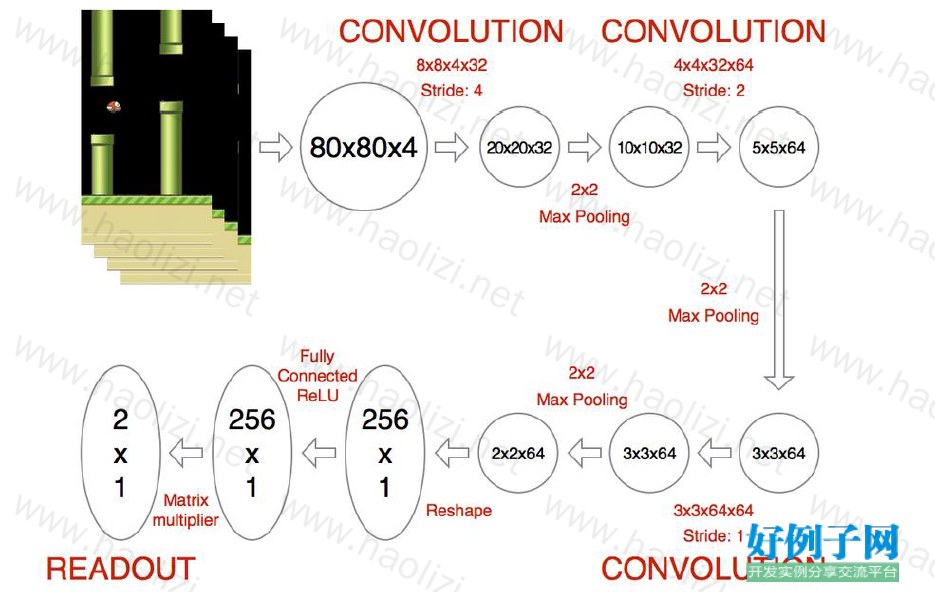实例介绍
目录
1.达到的目的
2.思路
2.1.强化学习(RL Reinforcement Learing)
2.2.深度学习(卷积神经网络CNN)
3.踩过的坑
4.代码实现(python3.5)
5.运行结果与分析
【实例截图】

【核心代码】
#!/usr/bin/env python
from __future__ import print_function
import tensorflow as tf
import cv2
import sys
sys.path.append("game/")
try:
from . import wrapped_flappy_bird as game
except Exception:
import wrapped_flappy_bird as game
import random
import numpy as np
from collections import deque
'''
先观察一段时间(OBSERVE = 1000 不能过大),
获取state(连续的4帧) => 进入训练阶段(无上限)=> action
'''
GAME = 'bird' # the name of the game being played for log files
ACTIONS = 2 # number of valid actions 往上 往下
GAMMA = 0.99 # decay rate of past observations
OBSERVE = 1000. # timesteps to observe before training
EXPLORE = 3000000. # frames over which to anneal epsilon
FINAL_EPSILON = 0.0001 # final value of epsilon 探索
INITIAL_EPSILON = 0.1 # starting value of epsilon
REPLAY_MEMORY = 50000 # number of previous transitions to remember
BATCH = 32 # size of minibatch
FRAME_PER_ACTION = 1
# GAME = 'bird' # the name of the game being played for log files
# ACTIONS = 2 # number of valid actions
# GAMMA = 0.99 # decay rate of past observations
# OBSERVE = 100000. # timesteps to observe before training
# EXPLORE = 2000000. # frames over which to anneal epsilon
# FINAL_EPSILON = 0.0001 # final value of epsilon
# INITIAL_EPSILON = 0.0001 # starting value of epsilon
# REPLAY_MEMORY = 50000 # number of previous transitions to remember
# BATCH = 32 # size of minibatch
# FRAME_PER_ACTION = 1
def weight_variable(shape):
initial = tf.truncated_normal(shape, stddev = 0.01)
return tf.Variable(initial)
def bias_variable(shape):
initial = tf.constant(0.01, shape = shape)
return tf.Variable(initial)
# padding = ‘SAME’=> new_height = new_width = W / S (结果向上取整)
# padding = ‘VALID’=> new_height = new_width = (W – F 1) / S (结果向上取整)
def conv2d(x, W, stride):
return tf.nn.conv2d(x, W, strides = [1, stride, stride, 1], padding = "SAME")
def max_pool_2x2(x):
return tf.nn.max_pool(x, ksize = [1, 2, 2, 1], strides = [1, 2, 2, 1], padding = "SAME")
"""
数据流:80 * 80 * 4
conv1(8 * 8 * 4 * 32, Stride = 4) pool(Stride = 2)-> 10 * 10 * 32(height = width = 80/4 = 20/2 = 10)
conv2(4 * 4 * 32 * 64, Stride = 2) -> 5 * 5 * 64 pool(Stride = 2)-> 3 * 3 * 64
conv3(3 * 3 * 64 * 64, Stride = 1) -> 3 * 3 * 64 = 576
576 在定义h_conv3_flat变量大小时需要用到,以便进行FC全连接操作
"""
def createNetwork():
# network weights
W_conv1 = weight_variable([8, 8, 4, 32])
b_conv1 = bias_variable([32])
W_conv2 = weight_variable([4, 4, 32, 64])
b_conv2 = bias_variable([64])
W_conv3 = weight_variable([3, 3, 64, 64])
b_conv3 = bias_variable([64])
W_fc1 = weight_variable([576, 512])
b_fc1 = bias_variable([512])
# W_fc1 = weight_variable([1600, 512])
# b_fc1 = bias_variable([512])
W_fc2 = weight_variable([512, ACTIONS])
b_fc2 = bias_variable([ACTIONS])
# input layer
s = tf.placeholder("float", [None, 80, 80, 4])
# hidden layers
h_conv1 = tf.nn.relu(conv2d(s, W_conv1, 4) b_conv1)
h_pool1 = max_pool_2x2(h_conv1)
h_conv2 = tf.nn.relu(conv2d(h_pool1, W_conv2, 2) b_conv2)
h_pool2 = max_pool_2x2(h_conv2)
h_conv3 = tf.nn.relu(conv2d(h_conv2, W_conv3, 1) b_conv3)
h_pool3 = max_pool_2x2(h_conv3)
h_pool3_flat = tf.reshape(h_pool3, [-1, 576])
#h_conv3_flat = tf.reshape(h_conv3, [-1, 1600])
h_fc1 = tf.nn.relu(tf.matmul(h_pool3_flat, W_fc1) b_fc1)
#h_fc1 = tf.nn.relu(tf.matmul(h_conv3_flat, W_fc1) b_fc1)
# readout layer
readout = tf.matmul(h_fc1, W_fc2) b_fc2
return s, readout, h_fc1
def trainNetwork(s, readout, h_fc1, sess):
# define the cost function
a = tf.placeholder("float", [None, ACTIONS])
y = tf.placeholder("float", [None])
# reduction_indices = axis 0 : 列 1: 行
标签: flappy bird flappy bird 深度学习 app
相关软件
小贴士
感谢您为本站写下的评论,您的评论对其它用户来说具有重要的参考价值,所以请认真填写。
- 类似“顶”、“沙发”之类没有营养的文字,对勤劳贡献的楼主来说是令人沮丧的反馈信息。
- 相信您也不想看到一排文字/表情墙,所以请不要反馈意义不大的重复字符,也请尽量不要纯表情的回复。
- 提问之前请再仔细看一遍楼主的说明,或许是您遗漏了。
- 请勿到处挖坑绊人、招贴广告。既占空间让人厌烦,又没人会搭理,于人于己都无利。
关于好例子网
本站旨在为广大IT学习爱好者提供一个非营利性互相学习交流分享平台。本站所有资源都可以被免费获取学习研究。本站资源来自网友分享,对搜索内容的合法性不具有预见性、识别性、控制性,仅供学习研究,请务必在下载后24小时内给予删除,不得用于其他任何用途,否则后果自负。基于互联网的特殊性,平台无法对用户传输的作品、信息、内容的权属或合法性、安全性、合规性、真实性、科学性、完整权、有效性等进行实质审查;无论平台是否已进行审查,用户均应自行承担因其传输的作品、信息、内容而可能或已经产生的侵权或权属纠纷等法律责任。本站所有资源不代表本站的观点或立场,基于网友分享,根据中国法律《信息网络传播权保护条例》第二十二与二十三条之规定,若资源存在侵权或相关问题请联系本站客服人员,点此联系我们。关于更多版权及免责申明参见 版权及免责申明



网友评论
我要评论